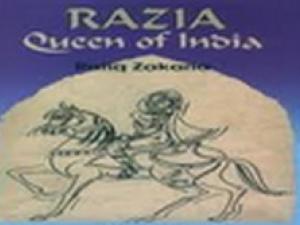Short Description
Islam liberated men and women from the shackles of slavery and made them masters of the world. The history of the Mamlukes illustrates this observation. In the 9th and 10th centuries, there was a brisk slave trade down the Volga River, near the Caspian Sea. The Vikings raided
Razia, Sultana of Delhi
Islam liberated men and women from the shackles of slavery and made them masters of the world. The history of the Mamlukes illustrates this observation. In the 9th and 10th centuries, there was a brisk slave trade down the Volga River, near the Caspian Sea. The Vikings raided Europe with unrelenting ferocity in search of booty and slaves. Eastern Europe, fossilized as it was between local fiefdoms, was a particular target of these raids. Men, women and children were captured in northern and eastern Europe, brought down the Volga River and sold to Muslim and Jewish merchants. Ibn Fadlun gives a graphic picture of the deplorable conditions in the Viking slave ships.
The root word in Arabic for Mamluke is m-l-k (malaka, to own). The European slaves were in great demand in Muslim courts because the men made excellent soldiers and the women were sought for their fair skin. Young Mamluke men were trained in special camps as bodyguards, taught the precepts of Islam and inducted into the army. The Spanish court of Cordoba as well as the Fatimid court in Cairo employed Mamluke bodyguards. However, it was with the rise of the Turks that the Mamlukes came into their own. The Turks displaced the Arabs and the Persians from the centers of power in Asia during the 9th and 10th centuries and became kingmakers. As the Mamlukes were inducted into the armies and the Turks dominated the armed forces, the slaves came to be referred to as Mamluke Turks. Some of the slaves were from Turkish tribes (prior to their conversion to Islam) in which case there was both an affinity of blood with their Turkish owners as well as an affinity of profession.
According to the Shariah, a Muslim may not hold another Muslim as a slave. Therefore, as the Mamlukes became Muslim, they became free men and women, with full privileges accorded to all believers. In an age when the path to kingship led through the army, the Mamlukes were not only great soldiers but were in close proximity to the center of power. Through their exploits they rose through the court ranks, married the daughters of the sultans and themselves became kings and sultans. Islam had taken them from the slave ships of the Vikings to the luxurious thrones of Asia and Africa. It was from the ranks of these Mamlukes that the 13th century dynasties of India and Egypt emerged.
Razia was the daughter of Altumish, a Mamluke who was a slave of Qutbuddin Aibak, Turkish sultan of Delhi. Altumish demonstrated such extraordinary abilities as a soldier that he was rapidly promoted to be a general officer in the army. Qutbuddin gave his own daughter in marriage to Altumish. After the death of his father-in-law, Altumish ascended the throne of Delhi (1211). He proved himself to be not only a first class soldier but an outstanding statesman as well. When Genghiz Khan descended upon Central Asia (1219), Altumish kept him out of India through consummate diplomacy and a determined military posture. Delhi and Lahore were saved from the ravages of the Mongols. Altumish had three sons and one daughter, Razia. The sons proved to be incompetent, more interested in wine and song than in the affairs of the state. Altumish therefore nominated his daughter to be his successor, against the advice of some of his courtiers and kadis. In accordance with her father’s wishes, Razia ascended the throne of Hindustan in the year 1236.
Altumish was an exceptional monarch not only because he rose from being a slave to become the sultan of one of the most powerful dynasties of the age, but because he broke with tradition and nominated his daughter as his heir-apparent in recognition of her merit and ability over his sons who were incompetent. Razia immediately faced a challenge from her brother Ruknuddin who had killed his own brother to intimidate Razia and force her to abdicate. Razia, a consummate politician, went public and in the Jamia Masjid of Delhi, appealed to the general populace for justice. The common folk displayed their intrinsic love of fair play. Ruknuddin was arrested for the murder of his own brother, tried before a Shariah court and executed.
Razia wasted no time in establishing her authority as the sovereign of Hindustan. She ordered coins minted in her name as “Pillar of women, Queen of the times, Sultana Razia, daughter of Shamsuddin Altumish”. The juma’a khutba was read in her name. However, her authority was not legitimate until the Caliph in Baghdad accepted it. Even though he had lost all of his dominions in Asia to the Mongols, the Caliph was still the spiritual and titular head of Sunni Islam and he carried the title of Emir ul Momineen (leader of the believers). Only he could bestow legitimacy upon a sultan. Razia, a Turk and a Sunni, declared her allegiance to the Abbasid Caliph with the following proclamation: “In the time of Imam al Mustansir, Emir ul Momineen, Malika Altumish, daughter of Sultan Altumish, she who increases the glory of Emir ul Momineen”. The Caliph recognized her as the “Malika” of Delhi (1237), in part because he needed a Sunni bulwark to the east of the vast territories now controlled by the Mongols, who were closing in on Baghdad itself.
To be continued.
Source:
https://historyofislam.com/contents/the-post-mongol-period/razia-sultana-of-delhi/






![نصيحتي لك: اذكر الله [1 / 12] نصيحتي لك: اذكر الله [1 / 12]](https://300035.dotdothktrade.tech/images/upload/content_thumbs/1913613138ragheb-al-serjany-videos.jpg)


Comments
Send your comment